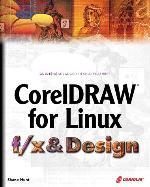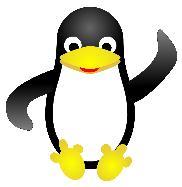
No getting bogged down with print issues and page setup, this book is about creating.

CorelDRAW for Linux: f/x & Design
Author: Shane Hunt
Publisher: Coriolis Group
Price: $49.99 US
ISBN: 1-57610-686-1
Reviewer: Clifford Anderson
It is without doubt that most computer books take more time to read than the program takes to learn. What is worse, these books can tire even the most studious person to the point of deflating that pumped up feeling that accompanies tackling a new program.
Fortunately, such is not the case with CorelDRAW for Linux: f/x & Design, by Shane Hunt (Coriolis Group, 2000). Hunt is not the kind of author that merely tells you about the program, like so many glorified help-file-style books. He writes to get the reader into the program. Well-written and slightly eccentric, the book will have the reader screaming for more with each chapter.
The title of the book is not misleading. Throughout the book, the author focuses on designing and creating great effects with CorelDRAW for Linux. No getting bogged down with print issues and page setup, this book is about creating. Coriolis Group calls their F/X Series of books the Creative Professionals Press. Hunt's delivery and content does not undermine the brand, but exemplifies it.
The book is made up of 18 chapters and has four to five projects per chapter, each of which stands alone in its own right. But, for the sake of his learning audience, he creates a linear movement, beginning with reasonably simple exercises before moving on to more complex projects. Let's take a look at one example from Chapter 2.
Shane gives a respectful but playful nod to his Linux readers by having us tackle creating our favorite mascot, Tux the Penguin. In 17 steps (less than a paragraph for each step), the student will have a hand made mascot right on their desktop. The fulfillment of this project comes from the fact that we made him from scratch. That's right. The head, body, flippers, feet, beak and eyes are all created by us, the readers (see Figure 1).

Figure 1. Tux the Penguin
How does he do this for us? The answer will reveal the content of Shane's book as well as what the reader can expect throughout the duration of his work.
Hunt teaches us like someone teaching a student driver. He's not going to describe every minor detail of the transmission before he allows us to get in the driver's seat. Rather, he says, “Here's where you sit, there's the steering wheel, the pedals, stick shift and windshield. Let's go.” From here, he shows and tells you how to drive while you are driving. This understanding of how to write for an audience who needs to be doing work (rather than reading about it) is what elevates this book as one that does not belong on your bookshelf but on your desk.
In Chapter 2, Hunt himself sums it up for us: “You don't have to be dripping with talent to be a good artist; you just have to learn how to use the tools that you have and be patient enough to work out any design problems that arise.”
When learning a vector-based drawing program, everything begins with a simple shape: a line, a circle, a square. Likewise for Shane's method. He embarks on a trek that begins with these simple shapes (just like our penguin friend) and then, through acquiring the necessary familiarity, technical expertise and willingness to participate, we acquire a knowledge and skill base that allows us to go far beyond the confines of his book.
Exactly how much can one acquire from one of Shane's projects? Consider our penguin, above. Once done, the reader will have had hands-on experience with over a dozen of CorelDRAW's tools with an equal amount of techniques for manipulating its features.
Immersion by example is what Shane's work is all about. The projects he gives us have to be seen rather than heard. But a short list will provide an inkling of what to expect. From the perspective of how CorelDRAW for Linux works, the reader will be exposed to editing shapes, working with transparency and shadow, creating blends and contour effects, as well as incorporating Bitmap (raster) images and modifying them within CorelDRAW's environment. From a creative stance, Shane has us designing ads and banners, optical illusions, chains, blades, barbed wire, comic book characters and celestial wonders. All this by no means exhausts the book's content.
The overall structure of the book caters nicely to a learning environment: lots of screenshots to determine where we are in the program, lots of images of the work in progress to evaluate our own work, plenty of secondary detail alongside the figures to add clarity to whatever tool or method we are currently using, and enough white space to add our own comments or notes.
Shane abides by the principle “tell them what you're going tell them, tell them, then tell them what you told them.” This proves to be an excellent heuristic device when going through the book's self-contained chapters.
Although Shane takes writing about CorelDRAW for Linux seriously, many of his examples may give the impression that his book is not to be taken seriously. If you're a technical illustrator who needs to know CorelDRAW as an occupational hazard, you may find yourself a little overly amused at some of the projects in the book. You're in need of creating a span bridge, and you're faced with a chapter on tattoos and barbed wire—consider it a challenge to expand your horizons to illustrate with diversity!
Most, if not all, of the book is about illustrating the fun stuff—things that look cool. This is Shane's trademark style and it shows—and works. But what is most important and justifies buying the book is its ability to have the reader master the immense girth of CorelDRAW for Linux while also becoming immersed in the program itself.
As a fellow purchaser of books, I am always asking the same question over and over as I thumb through the myriad publications for computer programs: what will this book do for me? And too many times the reply comes: not much. Such is not the case with this book. CorelDRAW for Linux f/x & Design by Shane Hunt, delivers. With every chapter and every project, the reader will be learning, using and mastering the well-known power that has made CorelDRAW a standard in vector-based illustration and design.